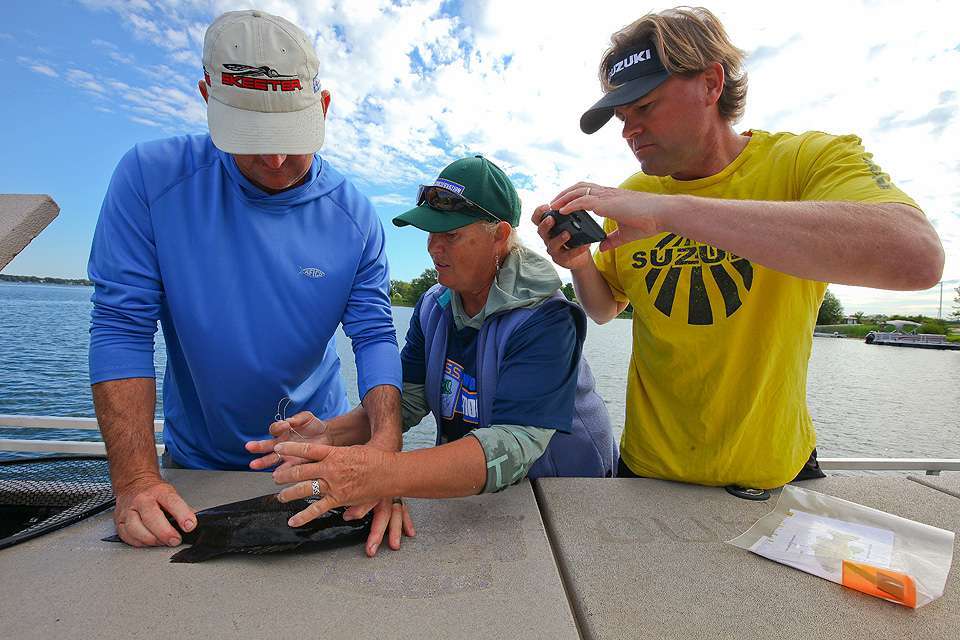
WADDINGTON, N.Y.—Barb Elliot was ecstatic as the boats idled past the Yamaha AFTCO Live Release Boat.
What made the New York B.A.S.S. Nation Conservation Director giddy were the well wishes from the 75 pros she individually trained in the process of fizzing deep-caught smallmouth.
“I did it, Barb!” and thank you gestures of every kind were expressed by the anglers approaching the weigh-in docks at the Berkley Bassmaster Elite at St. Lawrence River presented by Black Velvet.
The accolades resulted from the success of an initiative by B.A.S.S. management and the Elite Series anglers to step up fish care efforts at the St. Lawrence River. Smallmouth are prone to barotrauma, a condition experienced by deep-caught fish that are brought quickly to the surface. Fish experiencing barotrauma can have difficulty retaining the neutral buoyancy needed for recovery.
The solution is fizzing using a special needle that is inserted into the swim bladder to discharge trapped gas. When the fish reaches neutral buoyancy it can be released and can readjust to the changes in depth as it returns to deeper water.
“We are showing the world that we can run a bass tournament with a catch, weigh-in and release boat format,” said B.A.S.S. Conservation Director Gene Gillialand. “Our survival rate here is going to be great, thanks to the proactive care the anglers are doing in their boats before they arrive at the weigh-in.”
He continued, “This is a new paradigm that we are going by. We’ve never seen it before. It’s really exciting to see how the anglers are embracing this initiative to preserve the future of the sport.”
The anglers attended a mandatory fizzing class taught by Elliot during the three-day official practice. The release boat, docked at the weigh-in site, served as the classroom for the individual sessions. The anglers were allowed to bring two smallmouth to the class, with Elliot demonstrating the process on the first fish, and the angler fizzing the other.
“They didn’t come in with the attitude about just having to get it done as a matter of inconvenience,” she said. “They were hands on and wanted to know how to do this, why do it and the benefits of doing it.”
The hard work and dedication paid off at the weigh-in.
“I was amazed at the difference this made over previous years,” said Elliot. “At the weigh-in with the smallmouth you could see the vibrant colors of the skin and the brightness in the eyes, and how healthy they were.”
She continued, “Where we made the difference was having the fish fizzed on the water, where it matters the most.”
Waiting to do the process at the weigh-in can be too late. Enlarged swim bladders squeeze the heart muscle to limit its ability to pump blood through the body and to the gills, where the oxygen is exchanged.
“Fish care begins when the fish is hooked,” added Elliot.
Elliot also came up with the idea for the fizzing kit widely used by the anglers and the New York B.A.S.S. Nation. She obtained permission to disseminate information from a scientific research paper written by an expert on the topic, Canadian university research Steven Cooke.
She made a laminated card using the most pertinent information needed to fizz a fish aboard a boat. Photos of a smallmouth and largemouth with the landmarks—or needle insertion points—are shown at the location of the swim bladder. She also makes the special needle that includes a reamer to clear the needle point of tissue so the gas can escape.
“The needle leaves a very small hole that does not allow water to enter the swim bladder,” she explained. “The tissue grows back and closes the hole.”
Elliot said the idea for the clinic came from B.A.S.S., although she has long advocated hands-on training.
“This is a tactical style educational process that cannot be learned from a book,” she said. “There is no replacing the hands-on training, and there couldn’t be a better place to learn it than under tournament conditions.
One angler fizzed 30 smallmouth as he was culling during the course of the day. Some pros even came back for refresher sessions or to learn even more about the process.
“it’s a dream come true,” said Elliot. “We are really making a difference and now have the evidence to prove it.”





